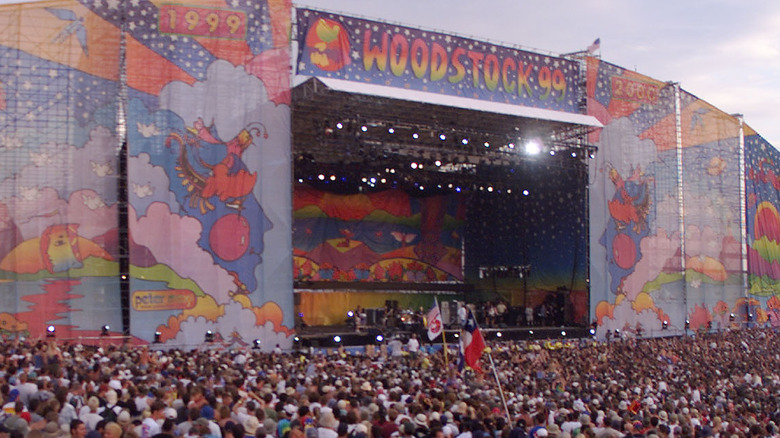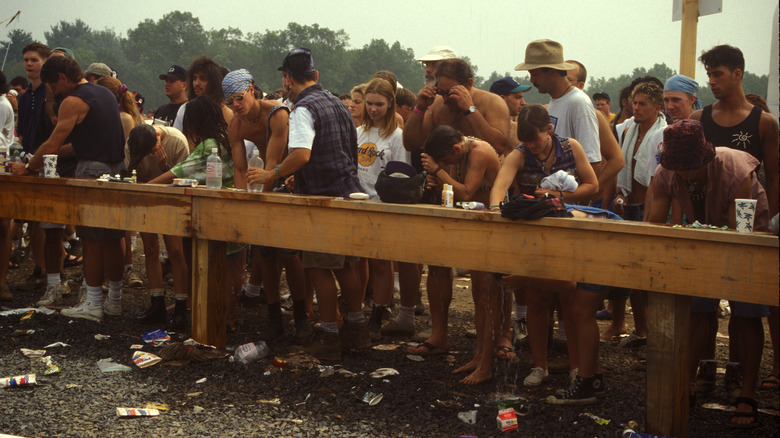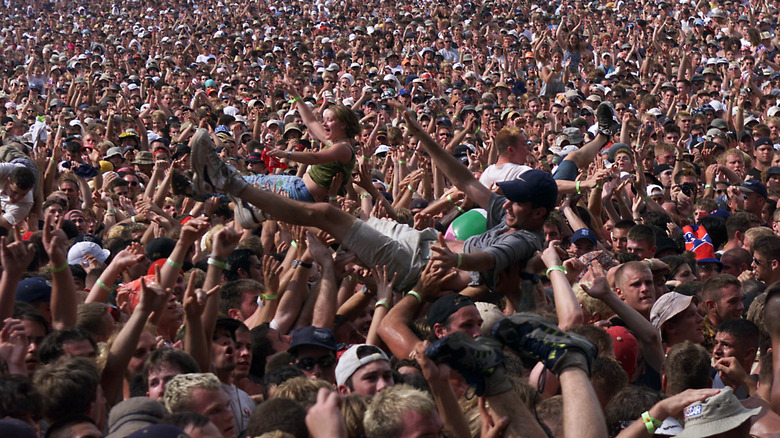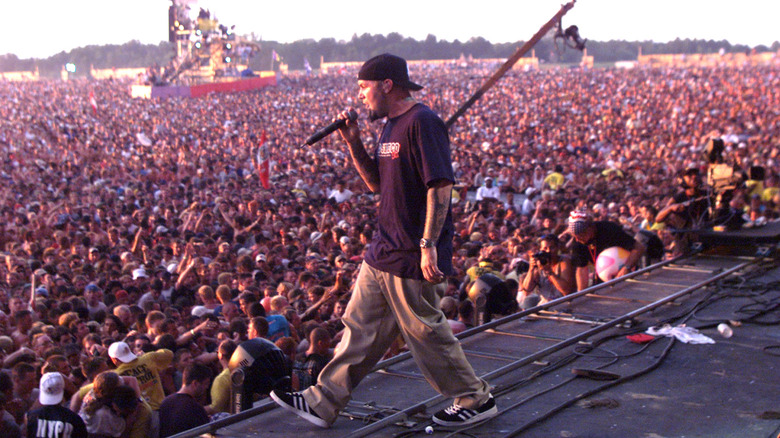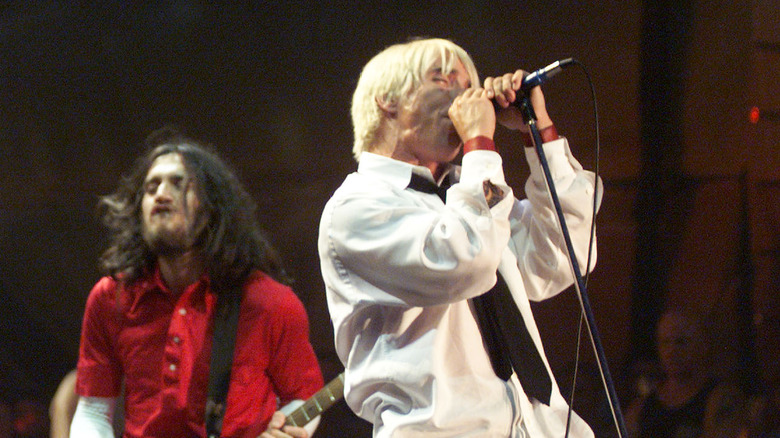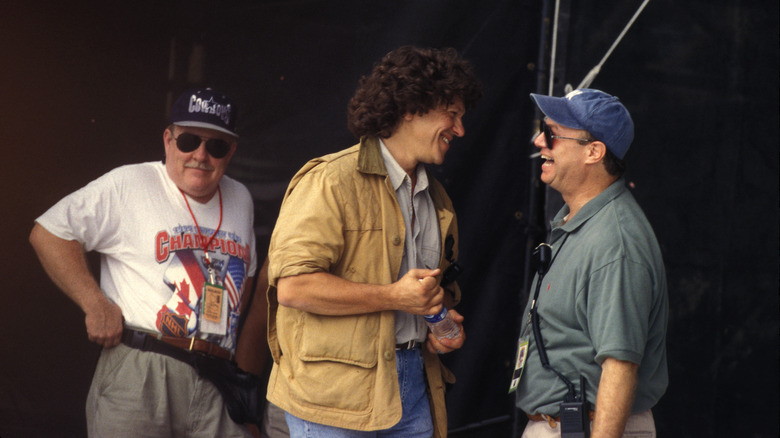The Truth About The Riots At Woodstock '99
If the Baby Boomers had the original Woodstock back in 1969, Generation X had Woodstock '99. This, however, was not the iconic festival the original Woodstock was. This wasn't "three days of peace and music" with Jimi Hendrix playing "The Star-Spangled Banner" on his Fender Stratocaster. This was Limp Bizkit's Fred Durst rapping about doing it "all for the nookie" and complaining about that he-says, she-says bull-bleep. This wasn't an event to look back on fondly while telling stories of your youth to your children ... or grandchildren. This was a cautionary tale for future generations of music fans and would-be organizers, one that definitely wasn't heeded by the Einsteins who put the Fyre Festival together. You should get the picture by now — OG Woodstock wasn't perfect, but Woodstock '99 was a failure of epic proportions.
When looking back on the debacle that was Woodstock '99, probably the first thing that comes to mind is the widespread chaos. There are so many ways to explain why the concert grounds were not a safe space for the average fan who headed to Rome, New York, to watch their favorite bands. And with the HBO documentary "Woodstock '99: Peace, Love, and Rage" set to premiere on July 23, 2021, let's take a closer look at what we know about the riots at the event.
The overpriced water and lack of sanitation made fans angry
Before actually touching on the riots, we have to look at the factors that made people angry enough to riot in the first place. And it would seem it largely boiled down to the lack of planning at Woodstock '99, which took place from July 22-25, 1999. While there was nothing anyone could do about the 100-degree temperatures, it did not help one bit that the food and beverages would've likely been cheaper if purchased at the Kwik-E-Mart; according to MTV, water was priced at $4 per bottle, and hot dogs cost $5 each. There wasn't much of a choice, either — if you wanted to drink free water from a fountain, chances are you would have been out of luck, as they were either turned off or the water was contaminated with raw sewage.
That brings us to the portable toilets, which were far from sufficient in number to accommodate the 220,000 or so fans who attended the festival, not to mention poorly maintained. Not long after Woodstock '99 kicked off, many of the port-a-potties were overflowing with human waste, and things only got worse in the days that followed. And as the crowds grew more restless and irate, it wasn't uncommon to see attendees literally bathing in their own filth. It's no wonder that scores of people got sick at Woodstock '99 — or had to go to the hospital, in many cases — due to the contaminated water and the overall lack of sanitation.
Misogyny was rampant at Woodstock '99
Content warning: Descriptions of sexual assault follow.
As pointed out by Rolling Stone's Brian Hiatt in his 20th-anniversary retrospective on Woodstock '99, it was understandable that more and more attendees were letting out their pent-up rage as the festival progressed. They were, after all, upset over the terrible conditions and the high prices of everything. However, he rightly opined that there was no excuse for the misogynistic behavior of many of the male fans at the event.
It was bad enough that female crowd-surfers were groped and that the men in the crowd chanted for the women to show their breasts. Sadly, there were also several sexual assaults that allegedly took place at Woodstock '99. One eyewitness, a medical worker, told Spin (via The Ringer) that he saw six female concertgoers assaulted at the festival; one of them was purportedly raped after a group of men dragged her into a mosh pit during Korn's set.
Other women, seeing how the misogyny and abuse was getting out of hand, opted to stay in the safety of their tents for most of the event. "I would say I was definitely pretty street smart and my Spidey sense was tingling, 'I'm gonna stick with my crew. I'm gonna stick with safety in numbers.' And anything outside of that was definitely something I was trying to avoid at all costs," Woodstock '99 attendee Stephanie Frizzel told The Ringer.
Fred Durst's role in the Woodstock '99 riots
And now, it's time to address the elephant in the room — the backward baseball cap-wearing, stuff-breaking, George Michael-covering elephant in the room. Much has been said about Limp Bizkit frontman Fred Durst's alleged role in encouraging the fans at Woodstock '99 to riot. You can judge for yourselves below, but as noted by Ultimate Classic Rock, Durst "seemed to be hoping for some sort of organized, victimless aggression" during his band's set. Good luck getting that from thousands of angry concertgoers, Fred.
"People are getting hurt. Don't let anybody get hurt," Durst was quoted as saying. "But I don't think you should mellow out. That's what Alanis Morissette had you motherf***ers do. If someone falls, pick 'em up. We already let the negative energy out. Now we wanna let out the positive energy."
Reacting to MTV anchor Kurt Loder's assessment of Woodstock '99's final day as scary and dangerous, Durst claimed that he didn't actually see anyone getting hurt. He said it was impossible for him and his bandmates to gauge the extent of the chaos while they were performing on an elevated stage in front of all those people. He also blamed the riots on the organizers, saying that they focused on "making some money and getting it in the quickest, easiest way."
Ah, the organizers. We'll get back to them later.
From breaking stuff to burning stuff: The riots reach a crescendo
Saying that Limp Bizkit's set was akin to Nero playing the fiddle while that other Rome burned is arguably accurate, but not as accurate as it would be if the analogy was used for Red Hot Chili Peppers' festival-closing set. Per Ultimate Classic Rock, that's when the Woodstock '99 riots reached their peak, though it wasn't like the anti-violence group Pax had bad intentions when they handed out candles to attendees. The plan was for the fans to light the candles while the Peppers performed their classic ballad "Under the Bridge," making for what should have been a show of peace and harmony.
Instead of using the candles for their intended purpose, concertgoers used them as tools of arson, burning the massive piles of garbage that accumulated during the four-day festival, as well as much of the "Peace Fence" that was used to prevent outsiders from sneaking in. To top it all off, RHCP ended their set with a cover of Jimi Hendrix's "Fire" — they apparently didn't plan such an ironic finale, but that's just what it was on the night of July 25, 1999.
With the Peppers' buck-naked bassist Flea raising his instrument in the air to acknowledge the crowd, Woodstock '99 was officially over — but not for the rioters who destroyed merchandise tents, looted ATMs, and added to the already significant property damage as fires continued to burn around them.
Woodstock '99 postmortem: The organizers initially refused to take the blame
The statistics in the aftermath of Woodstock '99 were downright depressing. According to Ultimate Classic Rock, there were eight rapes, 44 arrests, and around 10,000 people who sought medical assistance during the festival. There were also three people who died during, or immediately after the event, per MTV. Not to beat a dead horse, but this was a very far cry from the original Woodstock three decades prior, and the events of Woodstock '99 only served as ammunition for many a Baby Boomer who felt that their kids' generation was out of control.
Co-organizer John Scher seemed to dance around the issue when he was asked why during the event, he told reporters that everything was hunky-dory despite the myriad complaints of expensive refreshments, unsanitary conditions, and understaffed security teams. The outlet wrote that he instead chose to blame the unruly fans themselves and that he apparently answered one question with another question — why wasn't anyone asking him about all those problems during the festival itself?
Per MTV, Scher was, in fact, asked several times about the issues at Woodstock '99 while it was ongoing. And when he was pressed regarding the injuries sustained by concertgoers and the numerous instances of public nudity, he responded by "berating the reporters who asked them and laughing off the concerns or denying the allegations." However, Scher and his fellow organizers later issued a statement saying that they were "shocked and dismayed by the allegations of sexual abuse" and were working closely with authorities to help catch the perpetrators.
